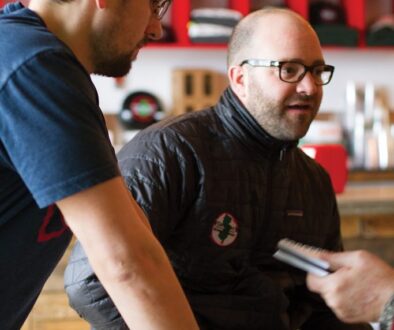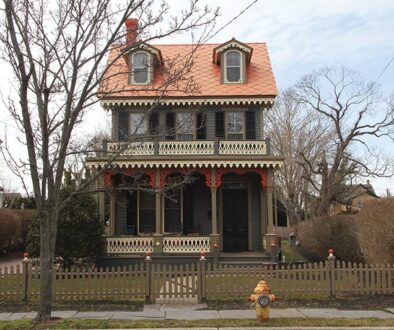Tapping into History

On an early morning in February, Cold Spring Village is still in hibernation. From the crushed clamshell parking lot you can see a few facades of the 26 buildings that make up this living history museum. As winter ebbs, they look perfectly frozen in time—a still, pastoral picture of the Early America we all read about in history books.
Everything’s quiet. Except over at the new, old barn.
Rising up before the Grange Restaurant, the barn is the latest addition to a collection of buildings dating back a couple of centuries, but today it could pass for brand new construction. The thawing earth around it is rutted with deep tire marks, piles of hay, and cleared brush. The broad sliding doors are stained a deep, toasted brown, and the roof has just been shingled. It smells like wet soil, cut wood, and new beginnings. You’d never guess the building’s over 200 years old.
Inside, the brain trust of the Village’s latest project has come together. There’s Anne Salvatore, founder and executive director of Historic Cold Spring Village, who’s just arrived with her husband, Joe, and their German Shepherd, Mitzi. She’s joined by Mark McPherson, a fourth-generation member of McPherson Masonry and avid home brewer, along with his daughter Maya (who makes fast friends with Mitzi). They’re here to talk about a new chapter at the Village: a plan that’ll pack the barn with visitors, tap into a rich vein of American history, and deliver a light buzz, to boot. They’re here to talk beer.

By late spring, the barn will house the county’s newest microbrewery, with a refinished interior, eight-tap bar, and a selection of beer you can’t find anywhere else. If you think that sounds like a great way to spend a Saturday, you’d be right. But it’s also Salvatore’s latest gambit to revitalize the Village in an economy that’s been tough on non-profits, particularly as a county subsidy runs out. With the wild success of outfits like Cape May Brewing Company (located at the nearby Cape May Airport), and the thriving business in the area’s many wineries, there’s no doubt Cape May County has some serious thirst. The question is: what makes this place any different?
Well, it starts with that barn. The Village houses the largest and best-kept collection of historic buildings in New Jersey, and this most recent acquisition maintains that reputation. Dated back to 1804, it’s a soaring, heavy-timbered pine and cedar structure: 2300 square feet, 23 feet tall, crossed and girded with heavy beams, and so open and lofty you’ll catch yourself listening for an echo. “It’s a three-bay English barn construction, which is classic,” says Salvatore, standing by one of the pillars. Petite and perfectly put together, she can’t hide her enthusiasm for the structure. “It’s sort of awe-inspiring when you think about it. This was built when Thomas Jefferson was president of the United States.”
Scouted up in Marmora by architectural historian (and friend of the Village) Joan Berkey, the barn was one of the only surviving structures on Peech Farm, which had suffered a recent fire. Builder Tom Barry initially purchased it for his own home, but after some persuasion from Salvatore, agreed to sell it to the Village, and even oversaw the painstaking process of transporting an antique building miles downstate. Each board and beam was carefully labelled, disassembled, and trucked to Cape May, where it came back together under Barry’s guidance, following plans drawn by architect John Lindemon. (This wasn’t the first move for the barn—look closely at the beams and you’ll find chiseled Roman numerals at the junctions, evidence of a much earlier “reassemble-by-numbers” effort.) The updated plan for the barn includes new construction in back of the structure for bathrooms, cold storage, handicap access and, most important, a designated brewery space.
As the conversation starts shifting to beer, Salvatore cedes the floor to Mark McPherson (who, incidentally, actually made the floor—his family company laid the foundation for the space).
“Mark is the star of all this,” Salvatore says, pointing over to where he stands assessing the equipment.
“I don’t know about that,” he calls back. “I think the building is the star.”
“The building wouldn’t be any good without you!”
He shrugs this off, slaps his hands together, and begins a whirlwind rundown of the brand-new brewing system, a collection of gleaming stainless steel vessels that, to the untrained eye, look almost interchangeable. Lucky for us, we have a very well-trained guide.
We start with a water filtration system. “Each beer lends itself to a different water characteristic—you can recreate that with different additives, but the water here will start out completely neutral,” McPherson explains, then quickly moves to the mill that crushes the raw base of the beer—toasted barley and assorted grains. The ground result is then mixed with hot water in a mash tun, at which point the vocabulary starts sounding distinctly Seussian. “A lot of these terms have been used throughout the history of beer,” McPherson says. “They haven’t changed.” The grain and hot water sit in the mash tun (which is a barrel) for about an hour, creating a sort of tea, which is called wort.
And once you have your wort, “you start sparging,” he explains. This sounds like an invented word for straining: the liquid wort is separated from leftover grain, then transferred to a boil kettle, where over the course of an hour (or more, if you aim for a stronger tipple) water evaporates from the mixture, and hops are added in. The initial dose gives beer its characteristic bitterness, but later additions help round out the flavor and fragrance profile—giving the brew added nuance, or as Mark puts it: “working in the characteristics that bring flavor to the front of the tongue, not the bitterness that gets you in the back of the tongue.”
From here, it’s largely a waiting game. The hop-enhanced wort is chilled to 70 degrees, then moved to a fermenter, where yeast works its magic—consuming sugar, and creating alcohol and CO2 (carbonation) as a byproduct. Over the course of two weeks (“sometimes it’ll get done faster if it’s a lower alcohol beer, sometimes higher alcohol beers take longer,”) McPherson will keep careful measurement of the brew’s sugar content, then give it a final burst of carbonation in a “brite tank” before it’s barrelled and rolled into the cold room for future tapping.
So what’s a Cold Spring beer taste like? Nobody knows. Nobody’s brewed it yet. “The problem is, the plumbing’s not installed. You can’t brew without the water,” Salvatore explains, with the resignation of a woman who’s had to adjust her deadlines. “The plumber’s great. He said ‘Annie, I can’t dig until the ground’s been dry for four or five days.’ There’s so much to consider,” she says. “Sometime you have to say ‘Okay, I can’t do anything about that.’” The brewing equipment only arrived last week after a shipping delay, but from all accounts it was a grand entrance. “When it finally arrived, we had twelve boxes out there, and Mark was like a kid in a candy shop,” she says. “He was using a crowbar to open up the boxes and everybody came to look at it. It was like a new child came.”
So instead of passing around beer samples, Anne and Mark toss ideas back and forth. Recreating period-appropriate brews is one of the biggest prerogatives for the brewery. Since it serves as an extension of Cold Spring Village, McPherson hopes to work out recipes that would have existed during “The Age of Homespun”—an era of history between the Revolutionary and Civil Wars, when most Americans lived in small, agriculturally based villages and made the majority of goods themselves. In essence, they were the original artisanal locavores.
But beer itself far pre-dates the United States, or the colonies, or even the last millennium. At least 5,000 years ago, the Sumerians had already assigned a goddess of beer, Ninkasi, and the beverage became a daily staple in the diets of the pharaohs. By the 6th century, self-contained communities of Benedictine monks brewed ale using a sweet, herbal additive called “gruit,” before harnessing the flavorful bite of hops in the 8th century. During this time, beer became a viable alternative to water, and continued as a major source of hydration for the next few centuries. Freshwater rivers and streams were certainly cheaper than man-made beverages, but also carried the risk of contamination, while beer—sanitized during the boiling process—was a sure-fire alternative. Even children enjoyed a cold brew, though at concentrations closer to near-beer than today’s offerings.
The appeal of the drink wasn’t lost on some of our first settlers, either. “The alcohol content in the beer kept it from spoiling, so it was very popular on transatlantic trips during that time,” McPherson says. “When the settlers first came in 1620 and landed on Plymouth Rock, they were drinking beer,” Salvatore adds. Or to put a finer point on it, they’d stopped drinking it.
“Well, they ran out of beer. That’s why they stopped,” Mark says. “I’ve heard on the History Channel that they were planning to land in Virginia, but they ran out of beer and pulled over in Plymouth.”
America has since become one of the largest producers of beer on earth (second only to China, which wins by sheer population demand). In 1810, squarely in the center of Cold Spring Village’s recreated era, there were about 132 breweries in the country—a number that ballooned to 4,130 after the Civil War. But the original American beer, dating back to those first Pilgrims, was certainly humble.
“Back then, they used whatever they could get their hands on,” Mark says. “I’ve been doing some reading, and people used everything, including acorns, to make beer.” An acorn ale may not show up on the menu anytime soon, but he’s got another local crop that sounds like a perfect fit. “Sorghum is one of the things that I would really like to experiment with,” he says. “It was harvested for its sugar. There were sorghum fields across the Parkway—it was called Sugarcane Highway—and they had a little railroad system where they’d load carts of it.” Beyond the regional history, McPherson likes the crop for its light, delicate flavor, and nearly non-existent gluten content.
“You know, we grew sorghum here at one time,” Anne says. “It grows very well—there’s no reason we couldn’t do a whole section of our field in sorghum and then you could use it here.”
Mark is definitely interested. When Anne mentions pumpkins, another Cold Spring organic crop (and common addition to fall brews) he nods along. “The possibilities are endless,” he says.
They’ve only just hit on the idea, but it’s a great example of the kind of synergy the Village nurtures. When you have 30 acres of land hosting an almost self-sufficient town—from bakery to brewery, farm to restaurant table—possibilities for cross-over are bound to arise. They even plan to grow hops along the fence by Seashore Road—not for brewing (professional grade plants need 16-foot trellises) but to show customers what exactly is in their beer. “It’s part of the educational mission we have for the village,” Anne says. “We’ll have a demonstration there so people understand the ingredient.”
That’s one of many plans for the brewery, and Anne fills in the blanks quickly. A tavern counter will extended from the interior walls, lined with saddle stools, so that visitors will find plenty of quiet nooks to catch up over drafts. Add to that picture a gas fireplace (built by Mark himself), a cleverly installed big screen TV, and a bar standing sentry before the brew equipment itself. There are talks of an outdoor fire pit, and plans to direct patrons to the nearby Grange restaurant for some belly-filling fare to help soak up all that beer. The New Jersey ABC (Alcoholic Beverage Commission) won’t allow the brewery to serve food on the one-acre premises, but the Village has already devised a few workarounds to keep their guests fed.
Cutting through the red tape was maybe the biggest hurdle when taking this project from dream to reality. “You have to have a lot of tenacity and perseverance to keep going,” says Salvatore, who shouldered most of the responsibility for advocating the brewery. She traveled to Trenton herself to meet with the ABC and lobby for the Village brewery, going up against a panel of lawyers in what turned out to be an unprecedented undertaking: “We hired a lawyer and discovered that the Village is the only non-profit that has ever applied for a microbrewery license in New Jersey,” she recounts. “So I sat there, and the ABC sort of hemmed and hawed and looked at each other, and then they said ‘There’s no rule that says a non-profit can’t apply for a microbrewing license, so go for it.’ So we said okay, and the process started.”
The brass in Trenton may have had the Village brewery jumping through hoops, but the top beer outfit in town, Cape May Brewing Company, has been an ally from the start. “Ryan’s wonderful,” Salvatore says of Ryan Krill, a founder of CMBC, and president of the Garden State Craft Brewer’s Guild. “We talked to him two years ago and told him what we had in mind, just so he didn’t hear it in the grapevine. And he was great, he’s a good guy,” she says. The Salvatores often stop by the brewery at the Cape May Airport, and good-naturedly endure ribbing from the founder. “He laughs at us—we go there, and we go to the beer festivals,” she says, explaining that, though she’s more of a Jack Daniels person, her palate’s recently opened up to flavored beers and brown ales.
Places like Cape May Brewing Company (and Slack Tide, and Glasstown, and Tuckahoe, and numerous other outfits in the area) are all in the business of the making delicious beer. But here at Cold Spring Village, they’ve got a bigger mission. A buzzed-about brewery could draw an entirely new audience to the living history museum, an enterprise four decades in the making. “When you have a place as big as the Village, you have to find a way to protect it for the future,” Salvatore says. “It’s not going to make it just as a history museum. The brewery’s a vehicle that we’re going to use to keep the Village alive.” And whether guests end up wandering into the Village proper, or simply park themselves on a barstool, they’re bound to learn a thing or two along the way.
There’s still plenty of work to do—sweeping up the sawdust and building the bar, settling on final recipes and getting the word out—but after two years, the timeline’s begun to accelerate as Salvatore, McPherson and company move toward a late-spring launch date. It’s easy to imagine the barn ringing with music, conversation, and the clink of glasses, while toward the back, those stainless steel tanks boil and pump and steam through the latest batch of beer. It’s a lively second act for a barn that’s seen three centuries. And as they serve drinks with 19th-century roots and present-day appeal, Cold Spring Village is redefining “living history” one pint at a time.







